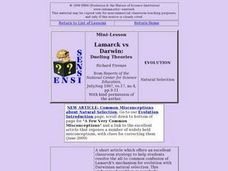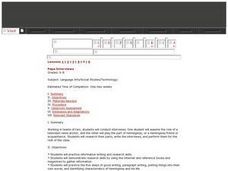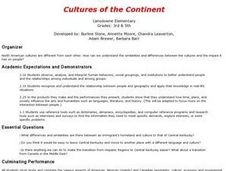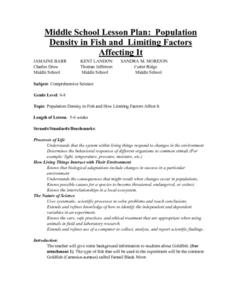Curated OER
Lamarck vs Darwin: Dueling Theories
Learners, in groups, study cheetah, blind cave organisms, and naked mole rats to explain facets of evolution.
Curated OER
Animal Diversity
Students examine plants and animals for their similarties and differences. They are read stories and note how the animals in the stories do not have the qualities that real animals have. They complete a worksheet to end the lesson.
Curated OER
Bats, Bats, Everywhere!
Students research information on bats while working in cooperative groups. They design posters with the information from their research.
Curated OER
Seed to Market
Students research using a variety of materials and technology. They explain the specifics of growing crops. They use mathematics in common business calculations.
Project SMART
Dinosaur Trek
Second graders investigate dinosaurs. They explore various websites, submit questions to a paleontologist online, construct cut and paste model dinosaur skeletons, develop a graph to compare dinosaurs, and label pictures from online...
Curated OER
Screwing Courage in Macbeth
High schoolers read, analyze, and act out the scenes 1.7.29-79 of the William Shakespeare play, "Macbeth." They discuss motivation, tactics, and obstacles, and improvise scenes suggested by the class.
Curated OER
Plants and Animals of Great Bay Animals and Plants of the Estuary
Students participate in a webquest about the plants and animals that inhabit an estuary. They role play as environmentalists researching this habitat and present the results of their research in a creative way.
Curated OER
Papa Interviews
Working in teams of two, young scholars conduct interviews by playing the role of a reporter and Hemingway. They research their parts, write the interviews, and perform them for the rest of the class.
Curated OER
Japan and The Ring of Fire
Students engage in a study of the volcanic forces and earthquakes associated with The Ring of Fire in the Pacific Ocean. The people of Japan are researched in how they have dealt with living in the area. Also students write in journals...
Curated OER
Microbiology Lesson Plan Aseptic Technique
Students examine the importance of aseptic technique, become familiar with media plates, and general microbiology techniques. They study the benefits and dangers of bacteria and other microorganisms in their lives.
Curated OER
Who Do You Think You Are?
Students discuss, and record significant events and people in their lives. They discover the reality of the past and recognize and attempt to project the future as a result of knowledge gained. They recognize and realize their...
Curated OER
Creation Mythology
Students construct a map from geographic data and explain relationships found in the information. Students identify ancient beliefs and customs through Hawaiian creation myths while comparing similarities and differences and appreciating...
Curated OER
Go Fish! Fish or other Sea Creature from Recycled Materials
Students create a unique, 3-d sculpture of a fish out of recycled materials. They brainstorm, what a fish looks like. Students research what fish look like. Also, students make sketches of their fish. Students write a reflection of...
Alabama Learning Exchange
Going Batty
Second graders participate in a research project involving bats. They collect information for their project on the Internet and other educational sites. They participate in a field trip to discover more about bats at the zoo.
Curated OER
Desert Animals
First graders investigate and identify a variety of animals that live in the desert. They complete a class KWL chart, then listen to the book Way Out in the Desert. Next, 1st graders observe a presentation of live desert animals, and...
Curated OER
Cultures of the Continent
Students explore the various cultures of North America. They examine the differences and similarities between an immigrant's homeland and the culture of Central Kentucky. Students discuss strategies to make the transition easier for...
Curated OER
Who is Rube Goldberg?
Fifth graders practice technology skills while searching online for information about inventor, Rube Goldberg. They discuss Rube Goldberg's use of simple machines, and write journal entries about their findings.
Curated OER
Plant Classfications
Seventh graders observe and discuss as a class the different types of vascular plants. They examine the different parts of the plant and some of the processes occurring in plants with activities accompanying.
Curated OER
Refining Your Public Speaking Skills
High schoolers use the rubric created in the Explore Lesson to help them craft an effective oral presentation worthy of a formal governmental hearing. They polish their oral presentations that are based on their position papers through...
Curated OER
Can You Beat Jet Lag?
Students examine the health condition of jet lag. Using mealworms, they test the effect of light on the development of them into adults. They answer discussion questions and examine the relationship of age and one's activity level.
Curated OER
VERTEBRATES
Seventh graders describe the main characteristics of warm-blooded vertebrate animals. They compare and contrast the two different groups of warm-blooded vertebrate animals by looking at external, reproductive, and growth characteristics.
Curated OER
Population Density In Fish
Students investigate how a population of fish multiplies in an ecosystem and the kinds of things that must be done to maintain a healthy population balance with other organisms that live there. They conduct an experiment to test the...
Curated OER
Matching Flowers With Their Pollinators
Students match flowers to pollinators and construct models of
flowers to demonstrate why different kinds of flowers need different kinds of
pollinators. They use their flower models and the "Scientific Method Format" included in the...
Curated OER
Looking and Learning in the Art Museum
Young art historians review the elements of art by studying a reproduction of a work of art from a museum visit. They explain the difference between looking at a reproduction of a work of art and looking at the original...























